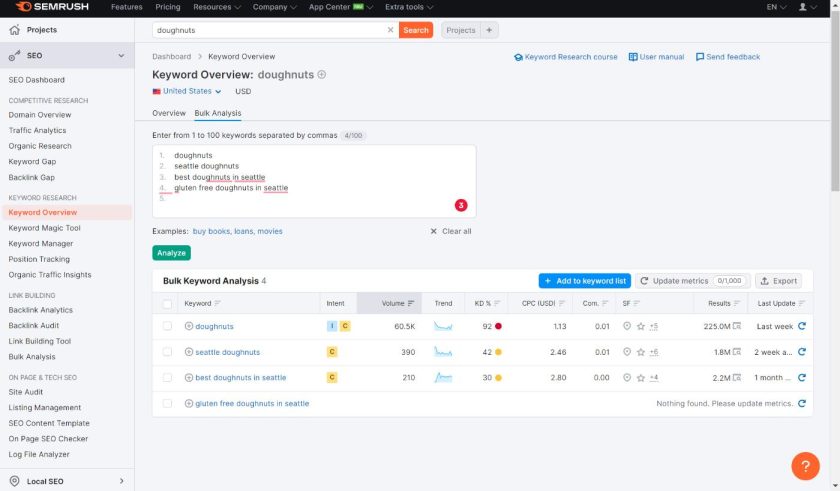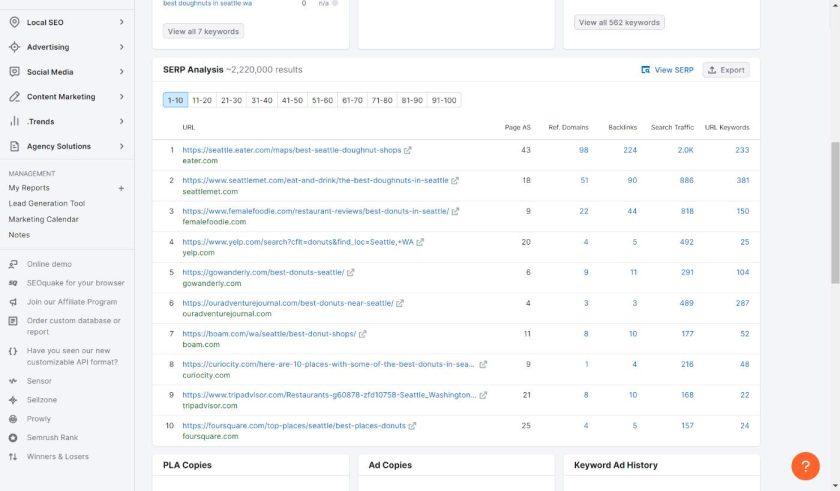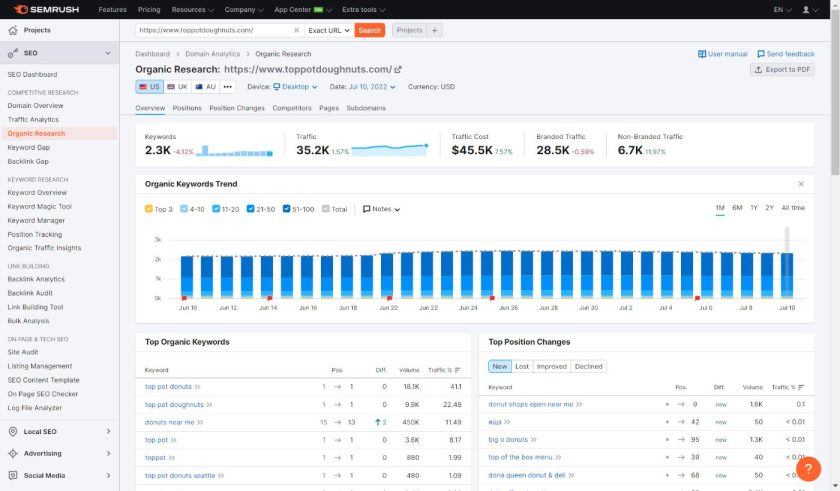Creating a content marketing plan can be daunting, even for the most seasoned among us, but certainly not impossible. At its core, content marketing is all about creating value for the people relevant to your business. It’s about communicating with your audience on the platforms where they’re most comfortable and building trust with your business. It’s about turning the spotlight on them and their needs.
SEO content marketing is all that, plus leveraging SEO strategies to ensure the right people discover your content. In my experience with content marketing, much of its success hinges on proper planning and a good understanding of your audience’s interests, needs, and behaviors. Keep reading for a step-by-step guide to creating a content marketing plan for your business.
Content marketing uses valuable, relevant content to attract audiences to your brand, like blogs, infographics, newsletters, and videos organically. It also builds your brand credibility, fosters engagement with your community, and even increases customer retention. Dive into what content marketing is and how it works.
Search engine optimization (SEO) is a set of strategies that helps your content be more discoverable on search engines—and seen by your audience. It involves keyword research, website optimization, and more. Explore our guide to search engine marketing.
How to Create an SEO Content Marketing Plan in 8 Steps
Creating a content marketing strategy is mostly about creating valuable, relevant content that addresses your audience’s interests, needs, and problems. But it’s not a simple matter of creating your content and waiting for your audience to come.
There’s a methodical approach to making good content. That’s where content marketing planning comes in. Below, I’ve outlined eight steps to help you create an SEO content marketing plan to help grow your brand presence online.
Step 1: Define Your Audience
The beginning and end point of all your marketing strategies is your audience. This is especially true for content marketing. To create good content that truly resonates with your audience, you need to know who they are. This means knowing not only their demographics, but also their interests, problems, needs, interests, and online behaviors, like the platforms they spend the most time on.
For example, say you own a vegan doughnut bakery and want to target young, health-conscious professionals. Research Gen Z and Millennial professionals in your area to identify their doughnut consumption habits and concerns and the kind of doughnut-related content they like to read and engage with. You can also research their values and pain points.
All these data points are essential to helping you craft good content for your audience. It helps if you already have a customer persona for your brand that highlights your ideal customer’s characteristics, interests, and pain points. They can help you define your audience more clearly. Here’s an example of one:
An example of a customer persona profile with characteristics and interests (Source: Fit Small Business)
Step 2: Set Goals and KPIs
Once you have a good understanding of your target audience, the next step in your content planning is outlining your goals. Content marketing is helpful for several purposes, from increasing your website traffic to helping generate leads. But the key to keeping it effective is having a clear goal and content marketing objectives.
- Increasing web traffic to your small business website
- Generating leads through newsletter signups
- Increasing sales (online or off)
- Upselling or cross-selling
- Improving customer retention and loyalty
- Improving your domain’s authority with Google
- Increasing rankings in online search
- Gaining backlinks from high-quality sites
Aside from setting these goals, it’s also important to identify your KPIs, or key performance indicators, to measure your progress and effectiveness.
Objective | KPI |
|---|---|
Increase website traffic | At least 70% website traffic by end of Q2 |
Generate new leads from submissions | At least 25% new newsletter signups by the end of the year |
Improve customer retention and loyalty | At least 50% repeat purchases |
Setting KPIs like these gives you measurable metrics to track your business’s growth. It also helps you identify if your content marketing strategies are effective or if you need to recalibrate them.
Step 3: Research Keywords & Competitors’ Content
This is the “SEO” part of your SEO content marketing plan. And the core of good SEO is keyword research. Research the keywords related to your business and product or service that audiences are interested in, and then build your content around those keywords.
Ideally, when someone searches online using those keywords, your website will be among the top-ranking ones in search engine results. This is critical for driving organic traffic to your website, landing pages, YouTube videos, social media pages, and other online marketing content.
There are two general types of SEO keywords: short- and long-tail.
- Short-tail keywords are general search queries of one or two words (e.g., “vegan doughnuts”). These keywords often have high search volume and keyword difficulty, making them harder to rank for.
- Long-tail keywords use three to five or more words (e.g., “best vegan doughnuts in Seattle”). Long-tail keywords are usually easier to rank for because they’re more specific but have lower monthly search volume than their broad (short-tail) counterparts.
You’ll want a good mix of both keyword types. The best way to find these keywords is through a keyword research tool. Personally, I use Semrush because it shows the monthly search volume for target keywords, how difficult they will be to rank for, and the websites that rank highest for those keywords.
Semrush is free to start, but you’ll only see up to a certain number of keywords. You’ll need to upgrade to a paid plan to see a full list. Overall, it’s one of the handiest tools I recommend to anyone wanting to build a content marketing framework.
Aside from researching keywords for your business, research your competitors’ content to give you a better idea of how to differentiate yourself. Semrush also has a tool for competitor research that can help you analyze content and rankings and compare domain vs domain.
Also, take some time to visit competitor sites and see what kind of content they’re producing and how often they’re publishing. You can also check what type of content attracts the most traffic. Then, use your insights to refocus your content on your business’s strengths, points of differentiation, and most compelling selling propositions.
Step 4: Brainstorm Content Ideas From Your Keywords
With your target keywords down, the next step is to brainstorm content topics from those keywords. Using your keywords as a basis, ideate content ideas around those topics. If possible, address their concerns and questions. You can also make mind maps around those keywords to ensure you cover your bases. As you brainstorm, make sure the topics are relevant to your audience’s interests, needs, and concerns.
For example, from the sample keyword search above, you find that a high-ranking keyword for your business is “gluten-free doughnuts in Seattle.” From here, you can determine if there’s general interest in gluten-free doughnuts in that area. Some content topics you might ideate are a guide to the best gluten-free doughnuts in Seattle or an explainer on what makes doughnuts gluten-free.
You’ll also find related keywords you can take inspiration from in the Related section of Semrush’s Keyword Magic Tool.
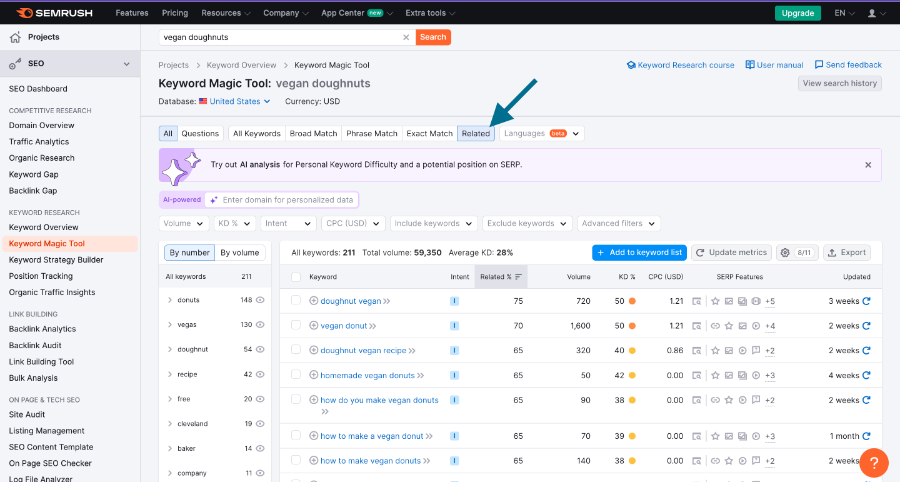
Semrush’s related section in its Keyword Magic Tool can also give you a list of related keywords. (Source: Semrush)
There are no wrong content ideas, as long as they’re all relevant to your keywords and audience. At this point, you want to ideate as many content topics as possible, because in the next step, you’ll start pruning and organizing them into the appropriate sales funnel stages.
Step 5: Identify Content for Each Stage of the Sales Funnel
Now that you have your content ideas down, this is the step to organize and designate them into the stages of the sales funnel. This is important because different content formats have different purposes. For example, infographics are good for letting people know about your brand (aka brand awareness), while demo content is better suited for the final stage of the funnel, converting people to customers.
Content at this stage should help build awareness or educate audiences about your brand’s personality, products or services, and mission and vision, to pique their interest.
When people are interested in a certain product or service, they usually start their research on search engines. This is the first stage of the customer journey. For example, a person living in Seattle may be looking for organic coffee alternatives in their area. They search online for “organic cafes near me” and begin exploring the content within the top organic search results.
Therefore, the content you create at this stage should answer top-level queries. Audiences here aren’t looking for in-depth information. They’re looking for simple, easy-to-understand answers. From the example above, the best answers to the sample search query would be blog posts listing the best organic cafes in Seattle or podcasts comparing the best options.
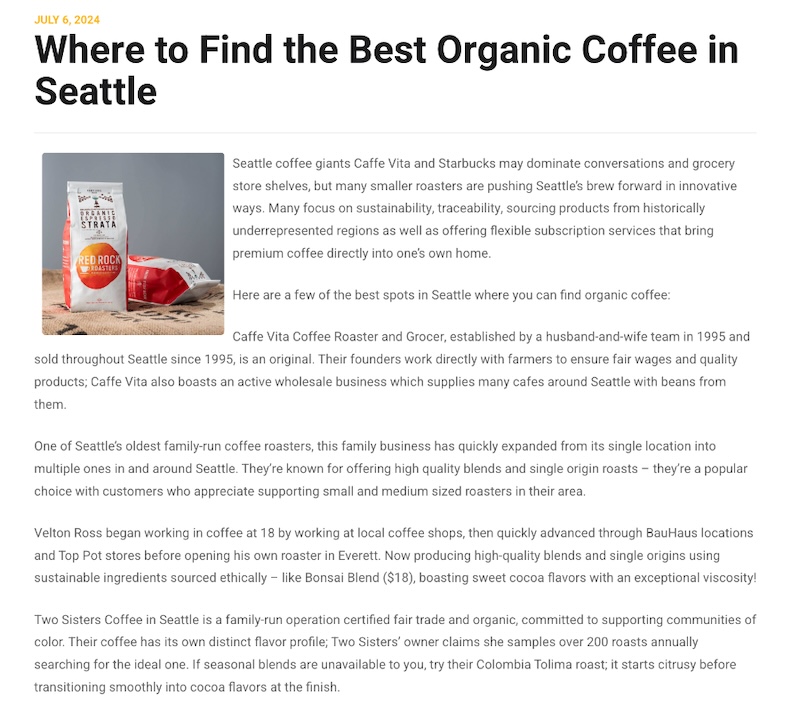
Content for awareness and lead generation, like blog posts, should provide top-level, overview-type answers. (Source: Zenco)
Other types of content for the lead generation (awareness) stage include the following:
- Informative blog posts like lists and tips
- Product or service explainer articles
- Whitepapers or e-books
- Video explainers
- Webinars
- Social posts and ads
- Infographics
- Citable content (e.g., trends or statistics)
- Video and audio podcasts
Articles like these bring your target audience to your website before they begin the buying process. They establish trust with your brand so that when they are ready to buy, your brand will be top of mind and your products will be the first they check out.
At this stage, your content should provide answers to frequently asked questions and differentiate you from competitors, to further lead audiences down the funnel.
Once prospects become aware of the products or services available to them, the next step they enter is the consideration stage, or when they consider which among their options is the best solution to their query. Here, they’ll consider factors like pricing, product or service quality, and benefits. Therefore, your content should be things like reviews, comparisons, and how-to’s, to help them make that decision.
Other types of content for the lead generation (consideration) stage include the following:
- Video guides and demos
- In-depth comparison articles (e.g., side-by-side vs. guides)
- How to articles and downloads
- Reviews
- Landing pages (to view a demo, schedule a meeting with a sales agent, or take advantage of a free trial)
At this stage, content should persuade leads from the consideration stage to complete a purchase.
At the decision stage, your audience knows they want or need a product or service they’ve been researching, and now they’re looking for confirmation or justification for their purchase. Essentially, they’re ready to buy but want reassurance that they’re making the right decision. They may also have narrowed options down to two or three, and want a reason to choose one over the other.
Therefore, your content at this stage should communicate why your business is their best option. You can do this by reemphasizing your unique selling point, showing demos of your product or service (and its benefits), or highlighting positive testimonials from previous customers.
Other types of content for the conversion or decision stage include the following:
- Case studies of your product or service
- In-depth reviews
- Testimonials
- Demos
- Free trials
Step 6: Establish a Content Calendar
When first implementing your content calendar, start with a manageable schedule. Many companies start by publishing one search-optimized blog post each week and then drive web traffic by sharing a link to the content on social media and in email marketing newsletters. Others publish multiple pieces of content weekly, while some sites even publish several articles per day.
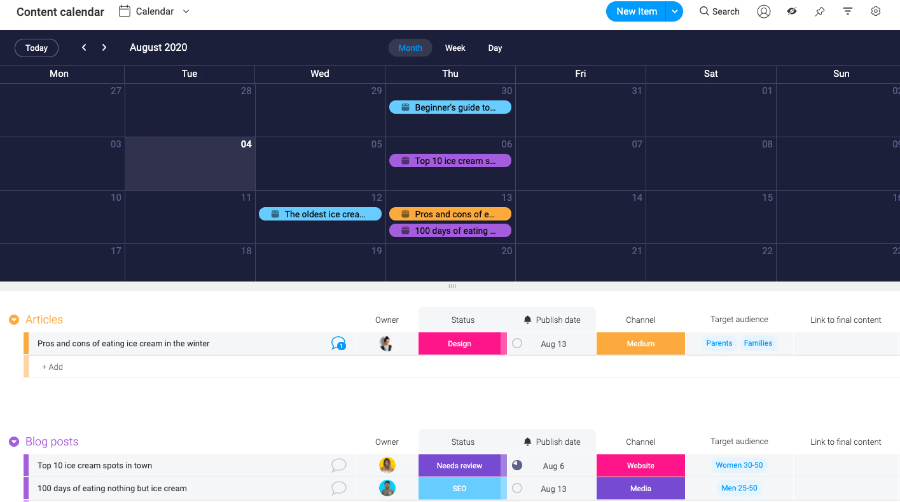
An example of a content calendar in monday (Source: monday.com)
You can create your first content publishing calendar using a spreadsheet. It can be as simple as a few columns for due or publish date, title, keywords, and target customer persona. To help you get started, here’s a free sample content publishing calendar spreadsheet you can download and customize for your process.
Thank you for downloading!
💡 Quick Tip:
Get multiple uses from the same content by turning a series of blog posts into an ebook and creating several social posts from one article.
No time to create? Get low-cost SEO content writing services from Fiverr for blog content, ebooks, social media, and more.
Step 7: Create and Publish Content
Now that your content marketing plan is in place, you can take action. At this stage, you can start creating your content using the keywords and topics researched above, and then schedule and publish it on your website.
Once you publish your blogs, go ahead and share them on your other channels, like your marketing emails and social media channels. While SEO content marketing is all about ranking on search engines like Google, there’s no harm in trying out other traffic sources.
Creating content regularly is no simple task but is necessary for SEO. One way to get help is by enlisting generative AI tools, something you may have heard of in recent years. However, no AI tool is perfect, so always double-check and edit all AI-generated content before using it for your blogs.
Search engines are evolving and ranking AI-generated content lower. That said, we have resources to help you incorporate AI into your marketing responsibly.
- Decide if AI is right for you with 21 AI marketing statistics.
- Find the best AI content writers to help you produce content.
- Need more than writing help? Generate captions, images, videos, and more with the best AI content generation tools.
- Explore what other businesses are doing with their AI for content marketing strategies.
Step 8: Measure Results & Refine Your Strategy
After you’ve published your content, the final step is to track its progress and measure your results, especially against the goals and KPIs you set in step two. Tracking your content’s metrics is important because your insights will help you create better and more refined strategies later on.
Some tools that can help you track your progress are Google Analytics and Google Search Console. Both are free to start and can offer insights about your site’s visitor demographics, click and conversion rates, and how it ranks for your keywords. Another site that can help is Semrush, which can also help you with technical details, like tracking your broken links.
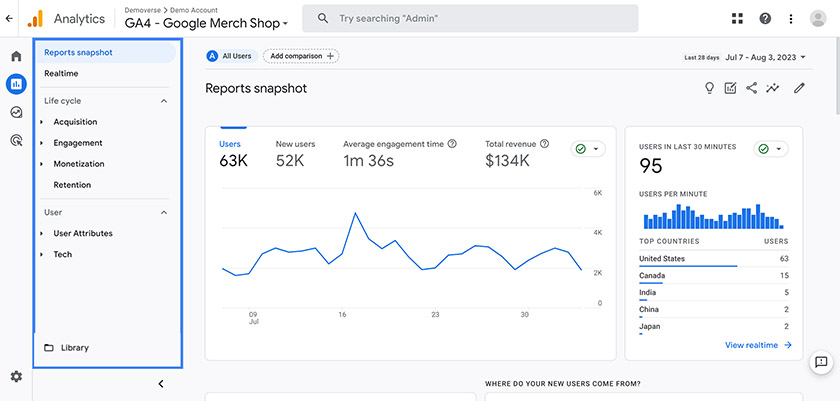
The Google Analytics dashboard (Source: Google Support)
Other SEO Content Marketing Strategies
The steps above cover all the essentials you need to start content marketing, but they’re not the be-all and end-all of SEO content marketing. SEO also involves other practices you can consider once your content is up and running. Here are some of them:
- Backlinking: With backlinks, other websites and blogs (ideally, high-ranking, authoritative ones) link back to your site. It boosts your SEO because it gives people more entry points to your site and indicates that your content is credible and trustworthy. There are many ways to get backlinks, including creating listings in online directories and publishing guest posts on other sites.
- Adding gated content: Once you have a steady stream of blogs, consider adding gated content to collect more leads. Gated content can only be accessed once readers input their email addresses (thereby giving you a lead). They’re usually downloadables like e-books, templates, and whitepapers.
- Optimizing your technical SEO: SEO isn’t just about content. It also involves technical aspects like your website’s speed and structure. To help you identify your website’s areas for improvement, run an SEO audit using SEO audit tools like Semrush and SE Ranking. They can give you detailed analyses to improve your site and rank higher on search engines.
- Leveraging social media content: As you may already know, social media is one of the most engaging platforms for content marketing. And with the right strategies, it can grant you an active and engaged follower community. You can even repurpose blog content into different formats for social media. Find out more about how to leverage social media marketing.
- Exploring paid content: The best content marketing plans are a mixture of organic and paid content. If you have any content you particularly want more engagement on or if you want to promote a specific blog, you can explore paid placements on search engines, otherwise known as pay-per-click (PPC) advertising. These give you guaranteed placements on top of search engines for specific keywords at a certain price.
- Exploring influencer marketing and brand ambassadors: On social media, influencer campaigns and brand ambassadors (aka customers who regularly post about your brand online) are steadily gaining traction as effective ways to promote online. All it takes is working with the right people who best encapsulate your brand values and personality.
Statistics About Content Marketing for Small Businesses
Content marketing is a proven long-term strategy for attracting and increasing organic web traffic. For this reason, it’s valuable for any business wanting to generate leads or sell online, as well as brick-and-mortar businesses that need to be discoverable by potential customers. It’s also essential for building your brand awareness and credibility as a thought leader in your industry or locale.
- Around 90% of industry experts had a content marketing strategy for their businesses in 2022—a considerable jump from just 77% in 2019.
- Approximately 89% of customers say watching a video convinced them to buy a product or service.
- According to a study by Aspiration Marketing, content marketing can increase lifetime value by up to 70%.
- HubSpot reports that up to 90% of leads they generate each month come from their blogs alone.
- When presented with different options, approximately 84% of consumers purchase from a brand that educates them via content.
Frequently Asked Questions (FAQs)
The elements to include in a content marketing plan are your goals and KPIs, the keywords you’re targeting, the types of content you’ll create under each stage of the sales funnel, and a content calendar to organize all your content pieces. Additionally, you can include customer profiles of your audience and their characteristics and interests.
The steps for content marketing include defining your audiences, setting your goals and KPIs, researching keywords for your content (and researching your competition), brainstorming content ideas, and distributing them across the sales funnel. Then, create a content calendar to organize your content. After publishing your content, track your progress and measure your results against your goals.
An SEO content marketing plan is a content plan to help your website rank in search engine results and be discovered by your target audience. This is done by researching keywords and using them to guide the content you publish on your site. An SEO content marketing strategy can increase website traffic, brand awareness, and credibility, generate leads, and convert.
Bottom Line
A good SEO content marketing plan can grow your brand presence online. It can get audiences to learn about your business and eventually convert to customers. Creating one is mostly about knowing who your audience is and their likes, interests, and pain points. From there, provide valuable content that addresses those needs, and find the right keywords to reach them effectively.
